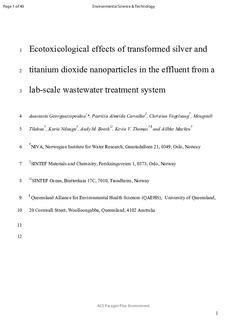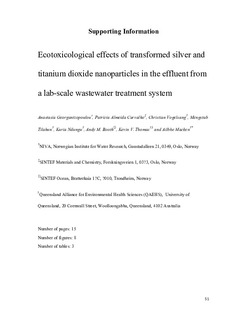| dc.contributor.author | Georgantzopoulou, Anastasia | |
| dc.contributor.author | Carvalho, Patricia A. | |
| dc.contributor.author | Vogelsang, Christian | |
| dc.contributor.author | Tilahun, Mengstab | |
| dc.contributor.author | Ndungu, Stephen Kuria | |
| dc.contributor.author | Booth, Andy | |
| dc.contributor.author | Thomas, Kevin V | |
| dc.contributor.author | Macken, Ailbhe | |
| dc.date.accessioned | 2018-08-24T07:31:18Z | |
| dc.date.available | 2018-08-24T07:31:18Z | |
| dc.date.created | 2018-08-21T10:38:11Z | |
| dc.date.issued | 2018-07-26 | |
| dc.identifier.citation | Environmental Science and Technology. 2018, 52 (16), 9431-9441. | nb_NO |
| dc.identifier.issn | 0013-936X | |
| dc.identifier.uri | http://hdl.handle.net/11250/2559158 | |
| dc.description.abstract | In this study, a lab-scale wastewater treatment plant (WWTP), simulating biological treatment, received 10 μg/L Ag and 100 μg/L TiO2 nanoparticles (NPs) for 5 weeks. NP partitioning was evaluated by size fractionation (>0.7 μm, 0.1−0.7 μm, 3 kDa-0.1 μm, < 3 kDa) using inductively coupled plasma mass spectrometry (ICP-MS), single particle ICP-MS and transmission electron microscopy. The ecotoxicological effects of the transformed NPs in the effluent were assessed using a battery of marine and freshwater bioassays (algae and crustaceans) and an in vitro gill cell line model (RTgill-W1). TiO2 aggregates were detected in the effluent, whereas Ag NPs (0.1−0.22 μg/L) were associated with S, Cu, Zn. Fractionation showed that >80% of Ag and Ti were associated with the effluent solids. Increased toxicity was observed during weeks 2−3 and the effects were species-dependent; with marine epibenthic copepods and algae being the most sensitive. Increased reactive oxygen species formation was observed in vitro followed by an increase in epithelial permeability. The effluent affected the gill epithelium integrity in vitro and impacted defense pathways (upregulation of multixenobiotic resistance genes). To our knowledge, this is the first study to combine a lab-scale activated sludge WWTP with extensive characterization techniques and ecotoxicological assays to study the effects of transformed NPs in the effluent. | nb_NO |
| dc.description.abstract | Ecotoxicological effects of transformed silver and titanium dioxide nanoparticles in the effluent from a lab-scale wastewater treatment system | nb_NO |
| dc.language.iso | eng | nb_NO |
| dc.relation.uri | https://pubs.acs.org/doi/10.1021/acs.est.8b01663 | |
| dc.rights | Attribution-NonCommercial-NoDerivatives 4.0 Internasjonal | * |
| dc.rights.uri | http://creativecommons.org/licenses/by-nc-nd/4.0/deed.no | * |
| dc.title | Ecotoxicological effects of transformed silver and titanium dioxide nanoparticles in the effluent from a lab-scale wastewater treatment system | nb_NO |
| dc.title.alternative | Ecotoxicological effects of transformed silver and titanium dioxide nanoparticles in the effluent from a lab-scale wastewater treatment system | nb_NO |
| dc.type | Journal article | nb_NO |
| dc.type | Peer reviewed | nb_NO |
| dc.description.version | acceptedVersion | nb_NO |
| dc.rights.holder | Copyright © 2018 American Chemical Society - Accepted manuscript © the author(s) 2018 | nb_NO |
| dc.source.pagenumber | 9431-9441 | nb_NO |
| dc.source.volume | 52 | nb_NO |
| dc.source.journal | Environmental Science and Technology | nb_NO |
| dc.source.issue | 16 | nb_NO |
| dc.identifier.doi | 10.1021/acs.est.8b01663 | |
| dc.identifier.cristin | 1603438 | |
| dc.relation.project | Norges forskningsråd: 238972 | nb_NO |
| dc.relation.project | Norges forskningsråd: 197405 | nb_NO |
| cristin.unitcode | 7566,6,0,0 | |
| cristin.unitname | Miljø og nye ressurser | |
| cristin.ispublished | true | |
| cristin.fulltext | postprint | |
| cristin.qualitycode | 2 | |


